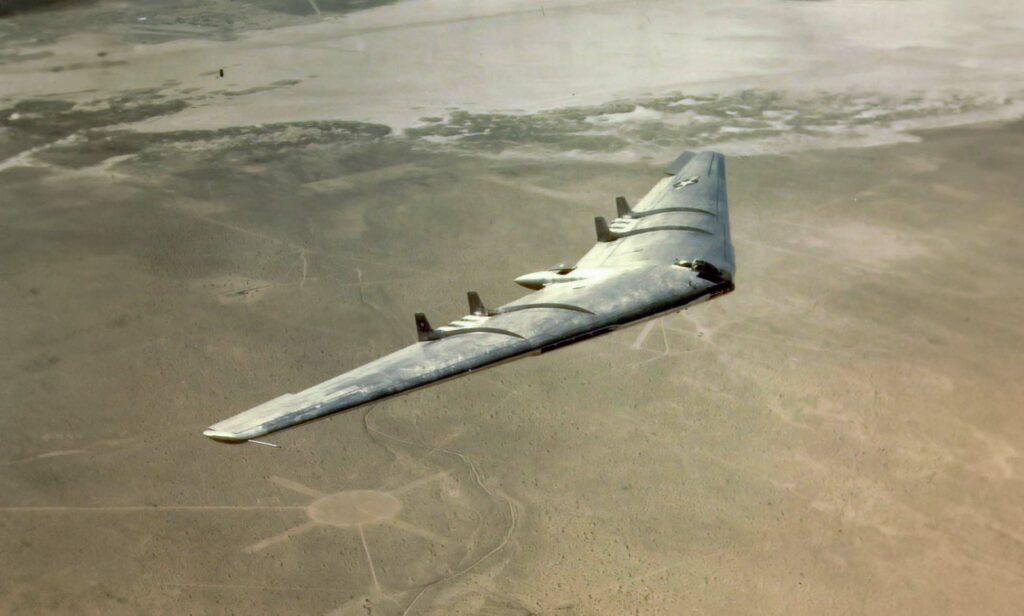The Northrop YB-49, a jet-powered flying wing bomber prototype, known for its radical design and advanced aerodynamics in the late 1940s.
This article provides an in-depth analysis of the Northrop YB-49, a revolutionary American jet bomber prototype of the late 1940s. It delves into the aircraft’s development history, its innovative design principles, performance characteristics, and military use. The development section details the strategic needs and design objectives behind the YB-49, while the design segment focuses on its technical specifications and the challenges faced. The performance analysis compares the YB-49 with contemporary aircraft, highlighting its unique capabilities. The military use section explores its potential combat roles and operational challenges, concluding with an assessment of its impact and legacy in aviation history.
The Northrop YB-49 represented a significant leap in aviation technology with its innovative flying wing design, marking a radical departure from conventional bomber aircraft designs of its time.
History of the Development of the Northrop YB-49:
Developed in the aftermath of World War II, the YB-49 was a response to the United States Air Force’s (USAF) need for a long-range, high-altitude jet bomber. Northrop Corporation, led by Jack Northrop, initiated the design, building upon the earlier piston-engine Northrop YB-35 flying wing design.
The program aimed to exploit the aerodynamic efficiency of the flying wing to achieve greater range and payload capabilities. The conversion from propeller-driven YB-35 to jet-powered YB-49 began in the late 1940s, with the first flight occurring on October 21, 1947. The YB-49 did not have a NATO nickname, as it was a prototype and not part of standard military service.
Design of the Northrop YB-49:
The YB-49 featured a radical flying wing design, eliminating the conventional tail and fuselage. It had a wingspan of 52.4 meters (172 feet) and was powered by eight jet engines housed in four engine pods. The design emphasized minimal drag and maximum lift-to-drag ratio.
However, the lack of a tail presented stability and control challenges, which were addressed using advanced computer-controlled flight systems. The aircraft’s innovative design also posed significant manufacturing and maintenance challenges.

Performance of the Northrop YB-49:
The YB-49’s performance was impressive for its time. It could reach a top speed of 805 km/h (500 mph) and had a service ceiling of 14,630 meters (48,000 feet). Its range was approximately 9,700 kilometers (6,000 miles), significantly higher than conventional bombers of the era.
In comparison to contemporaries like the Boeing B-47 Stratojet, the YB-49 had better range and payload capacity, but the B-47’s conventional design offered greater stability and ease of operation.
Military Use and Combat of the Northrop YB-49:
The YB-49 was never used in combat as it remained a prototype and faced several operational challenges, including issues with stability and structural integrity. The aircraft participated in various test flights and evaluations to demonstrate its potential as a strategic bomber.
While it did not directly compete with other aircraft in military operations, its design concepts influenced future aircraft developments, including modern stealth technology.
The YB-49 program was eventually canceled in favor of more conventional bomber designs, and the aircraft were decommissioned and scrapped in the early 1950s.
The Northrop YB-49 stands as a bold experiment in aviation history, showcasing the potential and challenges of the flying wing design. Despite its eventual cancellation, the YB-49’s advanced aerodynamic concepts and jet propulsion technology contributed to future developments in stealth and bomber aircraft designs, leaving a lasting impact on the field of aerospace engineering.
Back to the Bombers section.